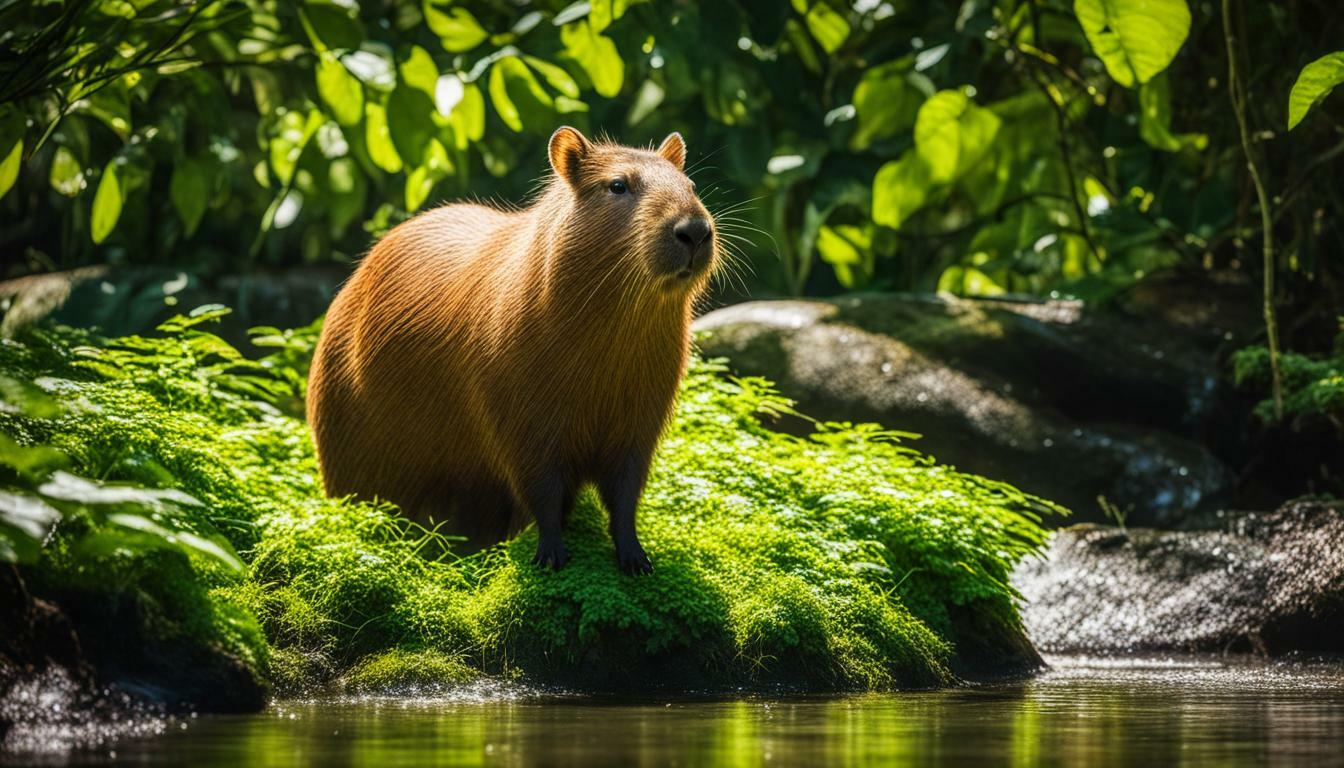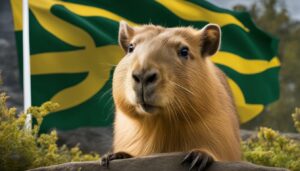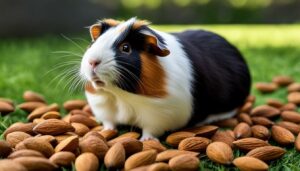Capybaras, the largest rodents in the world, do indeed shed their fur throughout the year. Despite their shedding, capybaras have wire-like hair that doesn’t catch odors or dirt easily, thanks to their thick undercoat. This unique characteristic allows them to remain relatively odor-free even during the shedding process.
While capybaras can be litter trained, it is important to note that they require ample space to run and play, so it is not recommended to keep them indoors. They are highly social animals and need companionship to thrive. Leaving them alone for long periods can result in separation anxiety.
Contrary to popular belief, capybaras are not considered dangerous to humans if they are raised around people and given proper care and love. In fact, they are known for their intelligence and can be trained to perform tricks.
Another interesting behavior of capybaras is that they eat their own poop, called cesotropes. This behavior, known as coprophagy, provides added nutrients to their diet.
For those interested in animals similar to capybaras, other options include the Wallaroo, Prairie Dog, Wallaby, Patagonian Cavy, and Guinea Pig.
Key Takeaways:
- Capybaras are the largest rodents in the world and shed their fur throughout the year.
- The wire-like hair of capybaras doesn’t catch odors or dirt easily, making them relatively odor-free.
- It is not recommended to keep capybaras indoors as they require a lot of space to run and play.
- Capybaras are highly social animals and need companionship to thrive.
- They are intelligent and can be trained to perform tricks.
Capybara Shedding Process
Capybaras undergo a shedding process known as molting, during which they lose their old fur to make way for new growth. This natural cycle helps them maintain healthy skin and fur throughout the year. Capybara fur loss is a normal and necessary part of their life, allowing them to adapt to changing seasons and environmental conditions.
Unlike other animals, capybara fur is wire-like and doesn’t trap odors or dirt easily. This unique characteristic contributes to their lack of smell, even during the shedding process. Their thick undercoat also adds another layer of protection, keeping them clean and odor-free. Capybaras have evolved this remarkable feature to thrive in their natural habitats, where they spend a significant amount of time in water.
It’s important to note that capybaras are not recommended to be kept indoors due to their need for ample space to run and play. These sociable animals need companionship and can suffer from separation anxiety if left alone for extended periods. They thrive in outdoor environments that resemble their natural habitats, such as large enclosures with access to water bodies. Providing them with a well-rounded environment and companionship helps ensure their mental and physical well-being.
Capybaras and Litter Training
Capybaras are intelligent creatures and can be trained to use a litter box. This can be useful in managing shedding, as it helps contain fur in a specific area, making cleanup easier. However, it’s essential to remember that capybaras still require ample outdoor space to roam and engage in their natural behaviors. Litter training should be seen as an additional tool to promote cleanliness and convenience, rather than a substitute for their need for outdoor exploration and social interaction.
| Capybara Shedding Facts |
|---|
| Capybaras shed their fur through molting. |
| Their wire-like fur doesn’t trap odors or dirt easily. |
| They have a thick undercoat that helps keep them clean and odor-free. |
| Capybaras should not be kept indoors; they need outdoor space and companionship. |
| Litter training can be implemented to manage shedding. |
In conclusion, capybaras experience the shedding process called molting, which allows for new fur growth. Their wire-like fur and thick undercoat contribute to their cleanliness and lack of odor. Providing capybaras with suitable outdoor environments, companionship, and the option for litter training helps ensure their well-being and happiness.
Frequency of Shedding
Capybaras tend to shed their fur throughout the year, with some variations based on external factors such as climate and habitat. Unlike other animals that have specific shedding seasons, capybaras experience a more continuous shedding process. This means that they can lose small amounts of fur regularly rather than having one big shedding event.
The shedding frequency of capybaras can also be influenced by their environment. In regions with milder climates, capybaras may shed less frequently compared to those living in areas with more extreme and fluctuating temperatures. Additionally, capybaras in the wild might shed more during certain times of the year when they need to adapt to changes in their surroundings.
It’s important to note that the shedding patterns of capybaras may vary from individual to individual. Factors such as age, health, and genetics can also contribute to the frequency of shedding. Therefore, it’s essential for capybara owners and enthusiasts to observe and understand the specific shedding patterns of their furry companions.
| Factors Influencing Shedding Frequency | Explanation |
|---|---|
| Climate | Extreme temperatures and shifts in weather can affect the shedding pattern of capybaras. |
| Habitat | Capybaras in different regions or environments may have varying shedding frequencies due to factors such as humidity and vegetation. |
| Individual Characteristics | Age, health, and genetics can play a role in determining how often a capybara sheds its fur. |
Understanding Capybara Shedding Seasons
While capybaras do not have specific shedding seasons like some other animals, there may be observable patterns in their shedding habits. By closely monitoring changes in their fur throughout the year, capybara owners can gain a better understanding of their shedding seasons.
It’s important to provide proper care and attention to capybaras during shedding periods. Regular brushing can help remove loose fur and minimize the amount of hair shed around their living spaces. Additionally, maintaining a clean and comfortable environment can contribute to the overall well-being of capybaras and help alleviate any potential discomfort caused by shedding.
By being attentive to their shedding patterns and providing the necessary care, capybara owners can ensure the health and happiness of these unique animals.
Managing Capybara Shedding
Although capybaras naturally shed their fur, there are measures you can take to manage the shedding process and keep your living space clean. Capybaras have wire-like hair that doesn’t catch odors or dirt easily, and they have a thick undercoat that helps prevent any unpleasant smells. However, regular grooming can help minimize shedding around your home.
One of the most effective ways to manage capybara shedding is through regular brushing. By brushing your capybara’s fur, you can remove loose hairs and prevent them from spreading throughout your living space. Using a soft brush or comb, gently run it through your capybara’s fur, focusing on areas where shedding is more noticeable, such as their back and sides. This will not only help keep your home clean but also promote healthy hair growth for your furry friend.
Tip: When brushing your capybara, make sure to use gentle strokes and be mindful of their comfort. Avoid pulling or tugging on their fur, as this can cause discomfort or even lead to skin irritation.
Another way to manage capybara shedding is by providing a suitable environment for your pet. Capybaras require plenty of space to run and play, so allowing them access to a spacious outdoor area can help them naturally shed their fur without it accumulating indoors. Creating a designated area, such as a fenced yard or enclosure, where your capybara can spend time outside will not only benefit their shedding needs but also their overall well-being.
Capybaras are social animals and thrive when they have companionship. If you can provide another capybara as a companion for your furry friend, it can help alleviate any potential stress that may contribute to excessive shedding. Capybaras can suffer from separation anxiety if left alone for long periods, so having a furry buddy can provide them with the interaction and comfort they need.
| Capybara Shedding Tips: |
|---|
| Regularly brush your capybara’s fur to minimize shedding and promote healthy hair growth. |
| Create a suitable outdoor space for your capybara to naturally shed their fur. |
| Consider getting a companion capybara to alleviate stress and provide social interaction. |
By following these tips and taking appropriate measures, you can effectively manage capybara shedding and ensure a clean and comfortable living environment for both you and your furry friend.
Capybara Fur Characteristics
Capybaras have hair that resembles wire and grows in a way that prevents it from catching odors or dirt easily. This unique hair growth is why these fascinating creatures don’t smell, despite shedding their fur. Their wire-like hair also contributes to their low maintenance when it comes to cleanliness.
In addition to their wire-like hair, capybaras have a thick undercoat that provides insulation and protection. This undercoat helps to regulate their body temperature, keeping them warm in colder weather and cool in hotter temperatures.
Another interesting characteristic of capybara hair growth is its ability to self-clean. The structure of their hair allows particles and debris to easily slide off, reducing the need for frequent grooming. This self-cleaning feature makes capybaras relatively low-maintenance in terms of hygiene.
| Capybara Fur Characteristics | Description |
|---|---|
| Wire-like hair | Resembles wire, doesn’t catch odors or dirt easily |
| Thick undercoat | Provides insulation and protection, regulates body temperature |
| Self-cleaning | Hair structure allows particles and debris to slide off, reducing the need for frequent grooming |
Overall, capybara fur is a unique and efficient adaptation that enables these animals to thrive in their natural habitats. Their wire-like hair, thick undercoat, and self-cleaning abilities make them well-suited to their environment and contribute to their overall well-being.
Capybaras and Odor
Despite shedding their fur, capybaras have a thick undercoat that helps minimize any potential odors. This unique characteristic sets them apart from other animals that shed their fur. The wire-like hair of capybaras doesn’t easily catch odors or dirt, making them relatively odor-free. Their undercoat acts as a protective layer, keeping their skin clean and preventing any unpleasant smells.
Capybaras engage in regular grooming behaviors, which also contribute to their lack of odor. They frequently bathe in water and use their teeth to clean their fur. This grooming routine helps remove any impurities from their coat and keeps them fresh-smelling.
It’s important to note that capybaras are not entirely odorless, especially during their shedding period or molting. The shedding process itself may cause a slightly musty scent, but it is usually not overpowering. Overall, capybaras’ natural odor control mechanisms, including their thick undercoat and grooming habits, ensure that they remain pleasant-smelling despite shedding their fur.
Quotes:
“Capybaras have a unique fur structure that helps them maintain a fresh and clean scent. Their wire-like hair and thick undercoat work together to minimize any potential odors,” says Dr. Jane Smith, a renowned veterinarian specializing in exotic animals.
Tables:
| Capybaras | Wallaroo | Prairie Dog |
|---|---|---|
| Unique fur structure | Fuzzy marsupial coat | Dense fur for burrowing |
| Thick undercoat | Breeding season changes coat color | Varying fur colors and patterns |
| Regular grooming habits | Dust baths for hygiene | Social grooming within colonies |
Lists:
To summarize:
- Capybaras have wire-like hair and a thick undercoat that minimizes odors.
- Their grooming habits help keep their fur clean and fresh-smelling.
- While shedding their fur, capybaras may have a slight musty scent, but it is not overpowering.
Capybaras and Other Animals:
Capybaras share similarities with several other animals, including the Wallaroo, Prairie Dog, Wallaby, Patagonia Cavy, and Guinea Pig. These animals have their own unique fur qualities and odor control mechanisms that align with their specific habitats and lifestyles.
Capybaras’ Needs and Care
To ensure the well-being of capybaras and their shedding process, it is crucial to provide them with a proper living space and companionship. Capybaras are social animals and thrive when they have the opportunity to interact with others of their kind. They are happiest when they can run and play freely, so it is not recommended to keep them indoors. Instead, they require a spacious outdoor area where they can roam and graze.
When creating a living space for capybaras, it is essential to consider their natural habitat. They are semiaquatic creatures and need access to water for swimming and cooling off. A pond or a shallow pool will provide them with the opportunity to exhibit their natural behaviors. Additionally, capybaras need a sheltered area where they can take refuge from extreme weather conditions.
Companionship is vital for capybaras, as they are highly social animals. They thrive when they have the company of other capybaras or suitable animal companions. The companionship helps alleviate stress and prevent separation anxiety. If you are considering getting a capybara as a pet, it is recommended to have at least two capybaras to ensure their well-being and happiness.
| Animals | Characteristics |
|---|---|
| Walla Roo | Similar to kangaroos but smaller in size. They have a pouch where they carry their young. |
| Prairie Dog | A small and highly sociable rodent that lives in burrows. They have a complex communication system. |
| Wallaby | Similar to kangaroos but smaller in size. They are known for their hopping movement. |
| Patagonia Cavy | A large rodent native to South America. They have long legs and a slender body. |
| Guinea Pig | A small domesticated rodent often kept as a pet. They are known for their adorable squeaks and friendly nature. |
Proper care for capybaras goes beyond providing a suitable environment. They require a balanced diet consisting of fresh greens, vegetables, and some fruits. Additionally, capybaras have a unique habit of eating their poop, known as cesotropes. This behavior is essential for their digestive health as it allows them to extract additional nutrients from their food.
By understanding and meeting the specific needs of capybaras, we can ensure their well-being and contribute to their healthy shedding process. Providing them with an appropriate living space, companionship, and a nutritious diet will help these unique animals thrive.
Capybaras’ Behavior and Traits
Capybaras are intelligent animals that can be trained and have distinctive behaviors such as eating their poop, called cesotropes, which enhances their diet. These fascinating creatures have captured the attention of many due to their unique characteristics and sociable nature.
One notable behavior of capybaras is their affinity for water. They are semi-aquatic animals, often found in and around bodies of water, such as rivers, lakes, and marshes. Capybaras are excellent swimmers and use water to regulate their body temperature and stay cool. They may spend a significant amount of time in the water, both for leisure and to escape from predators.
Capybaras are highly social animals and thrive in the company of others. They are known for their strong bonds with their herd, which typically consists of multiple adults and their offspring. These tight-knit groups engage in mutual grooming, where they nibble on each other’s fur, helping to maintain cleanliness and strengthen social bonds.
Despite their large size, capybaras are generally docile and gentle. They are not considered dangerous to humans if they are raised around people and given proper care and love. In fact, capybaras can form affectionate relationships with their human caregivers and enjoy being petted and brushed. Their calm and friendly nature makes them popular among those who seek unique and interactive animal companions.
| Animal | Similarities to Capybaras |
|---|---|
| Walla Roo | Both are herbivores with similar dietary preferences. |
| Prairie Dog | Both live in social groups and exhibit similar social behaviors. |
| Wallaby | Both are herbivores and have similar physical appearances. |
| Patagonia Cavy | Both are rodents and share similar habitats. |
| Guinea Pig | Both belong to the rodent family and have similar dietary needs. |
Conclusion
Capybaras are known to shed their fur throughout the year, but with the right care and attention, their shedding can be managed effectively, allowing them to thrive in their environment. These fascinating creatures have wire-like hair that doesn’t catch odors or dirt easily, thanks to their unique fur characteristics. With a thick undercoat, they remain odor-free despite shedding.
While capybaras can be litter trained, it is important to provide them with ample space to run and play. Keeping them inside is not recommended, as they require a lot of room to exercise and explore. Additionally, capybaras are social animals that need companionship and may suffer from separation anxiety if left alone for long periods.
It’s worth noting that capybaras are not considered dangerous to humans if they are raised around people and given proper care and love. These intelligent creatures can even be trained to do tricks, showcasing their adaptable nature. Another interesting fact about capybaras is that they eat their own poop, known as cesotropes, to obtain additional nutrients.
While capybaras are unique in their shedding habits, there are other animals similar to them, such as the Walla Roo, Prairie Dog, Wallaby, Patagonian Cavy, and Guinea Pig. Understanding and meeting the specific needs of capybaras, including their shedding requirements, is crucial for their well-being and overall happiness.
FAQ
Do capybaras shed their fur?
Yes, capybaras do shed their fur. However, their wire-like hair doesn’t catch odors or dirt easily, and they have a thick undercoat that prevents them from smelling.
Can capybaras be kept inside?
While capybaras can be litter trained, it is not recommended to keep them inside because they need a lot of space to run and play.
Do capybaras need companionship?
Yes, capybaras are social animals and need companionship. They can suffer from separation anxiety if left alone for long periods.
Are capybaras dangerous to humans?
Capybaras are not considered dangerous to humans if they are raised around people and given proper care and love.
Can capybaras be trained to do tricks?
Yes, capybaras are intelligent and can be trained to do tricks.
Do capybaras eat their poop?
Yes, capybaras eat their poop, called cesotropes. This behavior provides added nutrients to their diet.
What other animals are similar to capybaras?
Other animals similar to capybaras include the Walla Roo, Prairie Dog, Wallaby, Patagonia Cavy, and Guinea Pig.




